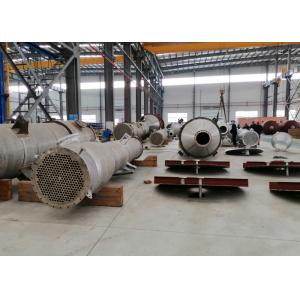

Add to Cart
High efficient TVR Stainless Steel Evaporator TVR Distillation Column Industrial scale with steam jet pump
TVR EVAPORATORS
TVR evaporators use Thermal Vapour Recompression to recompress a portion of the vapour from the vapour separator and mix it with the steam to heat the first stage.
Process for TVR evaporator
Thermal Vapour Recompression (TVR) normally takes place across one or more stages by utilizing medium or high pressure steam in an ejector which recycle a portion of the vapour from the vapour separator and mixing it with the steam. This mixture is used for heating of the first evaporation stage.
The steam consumption for a TVR evaporator will vary between approx. 0.3 - 0.07 kg steam per kg water evaporation depending on the number of stages over which the recompression takes place.
This design provides for less costly machinery than straight steam heated designs but requires motive steam pressure.
Thermo compressors
Thermo compressors are designed to recycle heat energy by capturing and recompressing waste steam for use elsewhere.
Thermo compressors, like ejectors, have no moving parts. The mechanical design consists of a steam chest, nozzle holder, nozzles, and diffuser.
The thermo compressor uses high pressure steam, as a motive fluid, which enters the steam chest and expands through the nozzle.
The high-velocity steam then entrains the waste steam, into a mixing chamber where the fluids are combined.
The mixed fluids are then recompressed to an immediate pressure through the diffuser, which acts as a nozzle in reverse, reconverting velocity energy to pressure energy.
Thermo compressors are designed for applications in the food, petroleum, chemical, power, and paper industries. Thermal recompression is typically applied in the dairy and juice industries to recapture and reuse steam from evaporators during the concentration process.
All thermo compressors are custom designed and performance tested to meet our client’s exacting specifications.
To learn more about thermo compressor heat recovery systems, and to discuss your specific process or application, please feel free to contact us.
Characteristics
Only a fraction of the evaporation energy has to be used in the form of live steam.
Low investment costs.
Retrofitting in existing plants is possible.
Suitable for various applications.
Variants
Increase in the number of stages to reduce steam consumption.
With or without salt separation.
Different preheating concepts.
Condensation of surplus vapour in mixing- or surface condensers.
| Performance Comparison for Different Evaporator | ||||
| Item | Single effect evaporator | multi-effect evaporator | TVR evaporator | MVR evaporator |
| Energy consumption | energy consumption is much higher than others, 1ton water will consume 1Ton steam in theory | comparatively energy conservation | Base on traditional multi-effect evaporator, one more effect added, but higher pressure steam driven needed | The most energy saving technology for evaporator, but 10-40kwh power consumption |
| Floor space | Small | large | large | small |
| Energy sources | steam & power, need steam pipe network and boiler | steam & power, need steam pipe network and boiler | steam & power, need steam pipe network and boiler, need high pressure steam. | electricity, don't need pipe network, all the close-loop circulation system |
| Automaticity | Semi automatic | Full automatic operation, continuous evaporation | Full automatic operation, continuous evaporation | Full automatic operation, continuous evaporation |
Working principle drawing
Workshop site
Certificate
